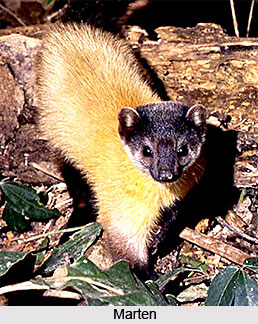 Marten belongs to the family Mustelinidae, which is related to otters, weasels and pole-cats but it is generally intermediate in size between otters and weasels, with more prominent ears and a body adapted for climbing and hunting in trees. There are three martens found in the Indian subcontinent, two of which are closely related and comparatively larger animals with exceptionally long tails. These are the beautiful Yellow-throated Marten (Martes flavigula) of the Himalayas extending to Assam, Burma, and Indo-Malaysia, and the Nilgiri Marten (M. gwatkinsi) confined to southern India, which is more rufescent in coloration where the former is black. The third species, the Beech or Stone Marten (Martes Fiona), occurs across the inner drier Himalayan ranges from Baluchistan to Sikkim in the east. The Stone Marten also occurs westwards in the mountains of Iran, Turkey and the Mediterranean countries.
Marten belongs to the family Mustelinidae, which is related to otters, weasels and pole-cats but it is generally intermediate in size between otters and weasels, with more prominent ears and a body adapted for climbing and hunting in trees. There are three martens found in the Indian subcontinent, two of which are closely related and comparatively larger animals with exceptionally long tails. These are the beautiful Yellow-throated Marten (Martes flavigula) of the Himalayas extending to Assam, Burma, and Indo-Malaysia, and the Nilgiri Marten (M. gwatkinsi) confined to southern India, which is more rufescent in coloration where the former is black. The third species, the Beech or Stone Marten (Martes Fiona), occurs across the inner drier Himalayan ranges from Baluchistan to Sikkim in the east. The Stone Marten also occurs westwards in the mountains of Iran, Turkey and the Mediterranean countries.
Marten possesses broad flattened skull with pointed inquisitive face and short powerful limbs enabling it to run swiftly up vertical tree-trunks. The animal is extremely agile while hunting in trees but look somewhat clumsy when travelling on the ground, as it arches its spine when running. It is essentially carnivorous, lives off birds and small mammals, but is known to have a distinctly sweet tooth, subsisting largely upon ripe fruit and berries in the season. The Yellow-throated Marten is passionately fond of robbing the combs of the wild hill bee.
The animal usually hunts by the day and all three species are adept at running through tree-tops and bounding from branch to branch. The Stone Marten is however often found in more open mountainous country and is not dependent upon forest covers as the other two species. It usually lives and hunts singly. Only the female cares for the young, which are born in the spring, usually in a tree cavity or cranny between rocks. Beech Martens have been recorded with litters of four to five and Yellow-throated martens with litters of two to three. The young accompany their mother on hunting expeditions until they are four to five months old.
The Beech Marten has two irregular creamy-white stripes down its throat and the rest of its body is dark glossy chestnut colour. It measures about thirty to forty five centimetres in body-length with a tail of twenty to twenty five centimetres, and weigh about 1.75 kilograms. The Yellow-throated marten has a black face and hind neck with a creamy-white throat darkening to yellow where it meets the back of the neck. The upper part of its body is grizzled silver blond and the long slender tail is equal in length to the body and may measure up to sixty centimetres. It weighs up to 3.5 kilograms. All martens have quite a repertoire of vocalizations from abrupt tock tock contact calls, to growling and hissing threat calls. It is relatively bold and fearless even when encountering man, but generally avoids the proximity of human habitations and in areas which are more heavily populated they hunt by night. All martens possess anal scent glands and mark their territory by rubbing these glands on prominent stones or clumps of vegetation.



















